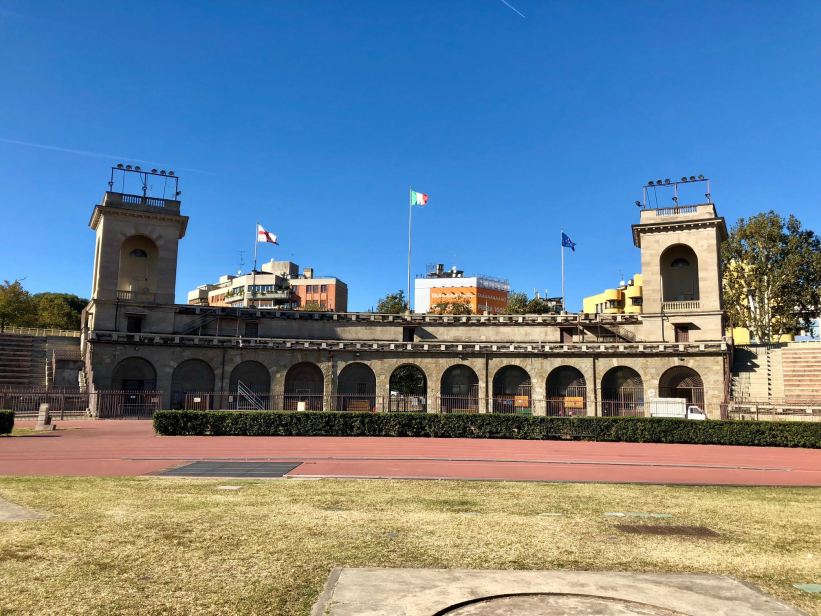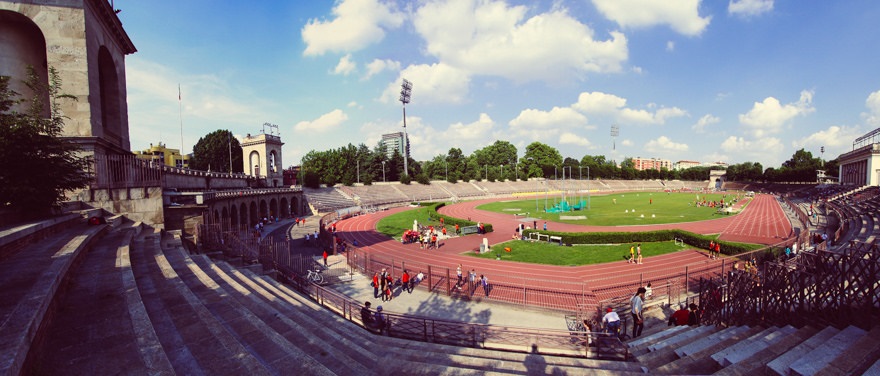Milano’s Parco Sempione is a hive of activity on a warm, autumnal afternoon; the gentle hum of a lawn mower, mothers pursuing their young children, dogs on leads and a steady flow of tourists here to explore the Arco della Pace (Arc of Peace) and Castello Sforzesco.
Most are oblivious, or perhaps even indifferent, to another monument which lies in the north-western corner of the park, partially concealed by the reds and browns of the arboretum. This is Arena Civica; Milano’s other iconic stadium.
Both Milan clubs have played at Arena Civica, but it is Inter who have a binding affinity to this spectacular relic. It was their fortress between 1930 and 1947; it played host to their early triumphs and now represents something of a spiritual home to the Nerazzurri.
The Arena has a fascinating and rich history that extends far beyond the birth of calcio. It was built at the request of Napoleon Bonaparte – the then recently crowned King of Italy in 1805 – who declared that the city needed a modern venue to celebrate and showcase its wealth. Whilst the Arena was inspired by the Circo Massimo (Circus Maximus) in Rome, it’s no coincidence that Napoleon chose a city that was devoid of such a structure to implement his own grand vision. The fort that previously occupied the site was razed and the Arena was built according to the design of Neoclassical architect Luigi Canonica.
Originally named Arena del Foro Bonaparte, it was inaugurated in 1807. It played host to an array of entertainers and performances – including the recreation of naval battles in miniature (the Arena floor could be intentionally flooded), chariot racing, Buffalo Bill’s famous Wild West Show (1894, 1906) and the finale of the first Giro D’Italia cycle race in 1909.
The Arena is located around five kilometres to the east of San Siro, close to the city centre. The façade of the Arena is, perhaps, slightly unremarkable in the context of more extravagant architectural offerings elsewhere in the city. But it is on the inside that a real sense of history pervades. Access can be gained via the western entrance, with just the briefest of nods to the security guard. From there you can cross the terracotta running track and take up a position on the pitch in order to admire the splendour of the deep stone terraces, the high pillared clubhouse and the ornate porticoes of the western entrance.

Inter had originally staged home matches at Ripa di porta Ticinese in the Navigli district – and then later at Via Goldoni. However, flood-prone playing surfaces and limited capacity at these venues meant Inter had frequently switched matches to the Arena over the years. This remained the case for the first two decades of Inter’s history, encompassing both their 1919/20 and 1929/30 Scudetti triumphs. In 1930/31, Inter took up permanent residence at the Arena following the tragic collapse of a grandstand at Via Goldoni.
The Napoleonic structure provided an excellent fit for the club, which traditionally represented the bourgeoisie of Milano. Whilst at the Arena, Inter won further Scudetti in 1937/38 and 1939/40, intersected by a Coppa Italia victory in 1938/39. Inter legend Guiseppe Meazza scored more than half of his 282 Nerazzurri goals at the Arena.
Ultimately, the combination of Inter’s growing popularity and damage sustained during wartime air raids meant that the love affair with the Arena could continue no longer. The Municipality of Milano had recently purchased Stadio San Siro from Milan, and were in the process of modernising and extending that venue, providing a natural successor to the Arena. Inter continued to train at the Arena into the 1950s (then under the guidance of Mister Meazza) and played the occasional game there too. Inter’s final match took in the Inter-Cities Fairs Cup – a forerunner to the UEFA cup – took place at the Arena, where they beat Lyon 7-0 in December 1958. Such was their attachment to the place, Helenio Herrera’s Grande Inter side returned there for their team photograph in 1962/63.
It’s not just Interisti who are entitled to feel sentimental about this illustrious venue. Herbert Kilpin’s nascent AC Milan played here in one of the first formal football matches ever to be staged in the city. Milan beat Mediolanum on 25 May 1900, disposing of Juventus two days later to win the Medaglia del Re (Medal of the King). Milan used the Arena as a training pitch and sporadically for Campionato matches through to 1914. Latterly, Milan switched their 1957 European Cup first Round match with Glasgow Rangers to the Arena, owing to the presence of a thick blanket of fog shrouding the San Siro. Notably, the Arena also hosted the first ever match of the Italian national side, running out 6-2 winners against France in 1910.
Today the Arena has been renamed in honour of sports journalist Gianni Brera, but continues to be used as originally intended; variously hosting football (Brera Calcio), rugby, athletics and concerts. The Torre Branca observation tower located adjacent to the Arena offers views over the city – and the rare opportunity to see both Inter’s past and present homes in a single panorama.
This hidden gem is unquestionably worthy of exploration – and there appears to be a remarkably relaxed attitude to visitor access to the Arena. The opportunity to stand in the footsteps of Milano’s footballing pioneers, to walk on the very same turf where great triumphs unfolded, and to draw in a deep breath of calcio heritage is surely not to be missed.
Words by Tom Griffiths: @CalcioEngland

